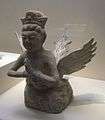Kalaviṅka
Kalaviṅka (Sanskrit: कलविङ्क kalaviṅka ; Chinese: 迦陵頻伽 Jiālíngpínqié ;[1] Japanese: Karyōbinga (迦陵頻伽),[2] Korean: 가릉빈가[3]; Vietnamese: Ca Lăng Tần Già; Burmese: ကရဝိက်; Thai: การเวก, Malay: karawek) is a fantastical immortal creature in Buddhism, with a human head and a bird's torso, with long flowing tail.[4]

The kalaviṅka is said to dwell in the Western pure land and reputed to preach the Dharma with its fine voice.[4] It is said to sing while still unhatched within its eggshell. Its voice is a descriptor of the Buddha's voice. In Japanese text, it goes by various titles such as myōonchō (妙音鳥, "exquisite sounding bird"),[5] kōonchō (好音鳥, "goodly sounding bird")[5] among others.
Edward H. Schafer notes that in East Asian religious art the Kalaviṅka is often confused with the Kinnara, which is also a half-human half-bird hybrid mythical creature, but that the two are actually distinct and unrelated.[6]
Depictions
In Chinese art
In Chinese mural art, it is portrayed as a human-headed, bird-bodied being, but in Japanese Buddhist art, it has been portrayed with an upper torso of a winged bodhisattva (i.e., having hands and arms), with a birdlike lower extremity. In the murals of Dunhuang (敦煌) they appear as figures both dancing and playing music.
 Grey pottery sculpture of a Kalaviṅka (missing its head) from the Yuan dynasty capital of Dadu.
Grey pottery sculpture of a Kalaviṅka (missing its head) from the Yuan dynasty capital of Dadu.
In Japanese art
A well-known example is the pair of kalaviṅka carved in openwork (sukashibori) onto a Buddhist hanging ornament called the keman, used in the golden hall of Chūson-ji temple in Iwate Prefecture. The kalaviṅka from this ornament was commemorated on a 120-yen definitive stamp issued Nov. 1, 1962.[7] The pose and general appearance on this piece is similar to the ones seen on the octagonal pedestal of the same temple (pictured right).
- In another keman from the Tokugawa period (see keman page), the creatures stand more bipedally erect and hence more humanlike.
- In the ancient courtly dance performance Gagaku - karyobin (迦陵頻) is the name of dance expressive of the kalaviṅka, and is danced in pair with the kochō (胡蝶), a dance of butterfly motif. The paired dancing is called tsugai-mai (番舞).
- A kalaviṅka painting by the brushstrokes of Hasegawa Tōhaku resides in Daitoku-ji (Kyoto), inside the Kinmōkaku (金毛閣) erected by tea-master Sen no Rikyū.
- Painted on the ceiling of Tōfuku-ji's Sanmon gate (Kyoto).
- Painted on the ceiling of Myōshin-ji's Sanmon gate (Kyoto), normally not open to public.
- The Mizusawa Kannon at 214 Mizusawa, in the former city of Ikaho, Gunma, Main Hall, front right ceiling, painting of a heavenly woman with eagle-like talons, anonymous.
- Kawakami Sadayakko (Sada Yacco), billed as the first overseas Japanese actress, late in her life, built a villa located at Unumahōshakujichō, Kagamihara, Gifu. The villa was christened Banshōen (萬松園) by Itō Hirobumi, and the room with the Buddhist altar has a ceiling painting of kalaviṅka, which may be peered from outside (but access to premises only on Tuesday mornings).
In Tangut art
The Kalaviṅka is a common feature of Tangut art created during the Western Xia period (1038–1227).
 Western Xia Glazed pottery Kalaviṅka-shaped architectural ornament.
Western Xia Glazed pottery Kalaviṅka-shaped architectural ornament. Western Xia Grey pottery Kalaviṅka-shaped architectural ornament.
Western Xia Grey pottery Kalaviṅka-shaped architectural ornament.
Popular culture
- (Manga)
- RG Veda by CLAMP: Ancient Hindu mythology theme. A sickly princess character.
- Dream Saga (夢幻伝説 タカマガハラ, Mugen Densetsu Takamagahara) by Megumi Tachikawa : based on Amano-Iwato legend. A sacred bird character.
- (Novels)
- Nightingale no chinmoku (ナイチンゲールの沈黙 Nightingale's silence) by Takeru Kaidō, bestselling medical fiction author:
- Takaoka Shnno Kokai ki(高丘親王航海記 Prince Takaoka's voyages) by Tatsuhiko Shibusawa
- Akame shijū ya taki shinjū misui (赤目四十八瀧心中未遂 Akame forty-eight waterfall suicide pact attempt) by Chōkitsu Kurumatani: Tattooed on the back of Aya, a female character.
- (Music)
- Kalavinka by Buck-Tick
- (Cycling)
- The Tokyo-based Tsukumo Cycle Sports's brand is Kalavinka. Many of the bikes feature the Karyōbinga kanji as well as a head badge which features the image of the karyoubinga with the head of a bodhisattva bosatsu and the winged body of a bird.[8]
See also
References
- "迦陵頻伽 - 教育百科". Cloud.edu.tw. Ministry of Education, Republic of China. Retrieved 2010-01-11.
- Hepburn, James Curtis (1903). A Japanese-English and English-Japanese dictionary (google). p. 270.CS1 maint: ref=harv (link)
- "평창 올림픽 개막식 인면조의 정체는 '가릉빈가'?" (in Korean). Retrieved 2018-05-17.
- Shinchosha (1985). 新潮世界美術事典 (Shincho Encyclopedia of World Art). Shinchosha. ISBN 4-10-730206-7.
- Kojien dictionary, 2nd rev. ed., 1976,
- Schafer, Edward H. (1963). The Golden Peaches of Samarkand: A Study of Tʻang Exotics. University of California Press. p. 103.
- The American Philatelist, volume 76, number ?, 1962, p.70: "A 120-yen stamp in one-color photogravure will be released Nov. 1. 1962, depicting Keman-no-karyōbinga
- http://www.kalavinka-bikes.com/index_j.htm